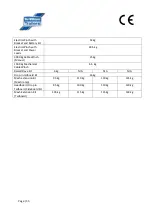
Page | 47
•
Any signs of rust or fraying on the inner cable or rusting of the threaded end such that the
adjuster nuts cannot be turned is cause for immediate replacement.
5.8 Coupling Maintenance
5.8.1
–
Bellows
5.8.1.1
–
Checking Bellows
•
Check the drawtube bellows for splits before every journey. Normal use creates a pumping
effect as the brakes are applied and released and dirt and moisture will soon be drawn in
through a split bellows.
•
Damaged bellows should be replaced at the earliest opportunity and not less than within 24
hours of discovery. Failure to do so will result in the drawtube becoming corroded and, as it
becomes resistant to sliding, the trailer brakes become less effective and eventually stop
working all together.
5.8.2
–
Coupling Head
5.8.2.1
–
Checking the Coupling Head
•
Check that the un-
coupled Coupling Head Wear Indicator is not beyond the “MAX” position
(see image in section 3.3.1.) If it is then replace the Coupling Head.
•
Replacement of the coupling head (if required) entails releasing the damper within the
drawtube. It is therefore essential to carry out the Damper check test described in section
5.8.3.1 below, in case the Damper also needs replacing.
•
The internal working surface Coupling Head should be periodically cleaned and regreased
with LMP grease.
5.8.3
–
Coupling Damper
5.8.3.1
–
Checking the Coupling Damper and Drawtube
•
With the handbrake ON (handbrake lever right back) push the Coupling Head as far back
towards the body of the Coupling as it will go
–
about 8cm. A steady force is required and
travel will be slow because the function of the Damper is to slow all movement.
•
If the Drawtube will not allow the Coupling Head to move back, despite considerable force,
then it is likely the drawtube is siezed, possibly due to water ingress and consequent
corrosion. As a first step and in order that the damper check can be completed, pump grease









































